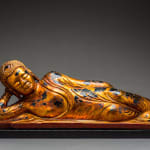Vietnamese Gilt Wooden Figure of the Reclining Buddha, 1800 CE - 1900 CE
Wood
22 x 62 cm
8 5/8 x 24 3/8 in
8 5/8 x 24 3/8 in
AM.0137
Delicate sculpture of the reclining Buddha, one arm resting on his side, the other supporting the head slightly bent on one side, his face with a serene smile and the...
Delicate sculpture of the reclining Buddha, one arm resting on his side, the other supporting the head slightly bent on one side, his face with a serene smile and the eyes half cast in meditation, his sanghati softly draped. In Buddhism, the parinirvana is traditionally understood to be within reach only upon the death of someone who attained complete enlightenment. It is the ultimate goal of Buddhist practice and implies a release from the cycle of deaths and rebirths as well as the dissolution of all mental aggregates (form, feeling, perception, mental fabrications and consciousness).The historical Buddha is believed to have died and reached parinirvana (or Maha Parinirvana) around 544 BC in the site of Kusinagar in India. Such event has been depicted copiously throughout East Asia and had a profound effect on the Theravada Buddhist iconography of Southeast Asia, where very large versions of the reclining Buddha are indeed to be found. This image of the reclining Buddha emanates a sense of cultivation and grace. Its polished appearance and serenely reposed body bespeaks of the Buddha's exalted and transcendental existence. Propping the head with one hand, the Buddha rests its smoothened hair and ushnisa facing forward with a tranquil expression, at the point of his final departure from his earthly existence. The features are well-defined-- arched eyebrows, narrow eyes, long nose, delicate mouth and elongated earlobes. This reclining Buddha takes on a beautiful form, with soft curves and twists in the body arranged to convey the spiritual opulence and transcendental detachment of Buddhahood.



